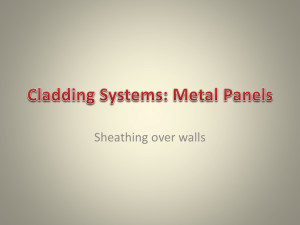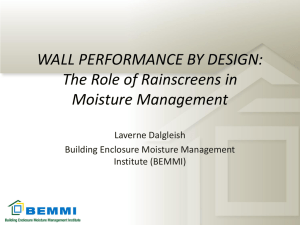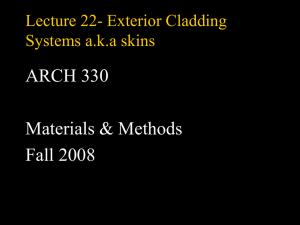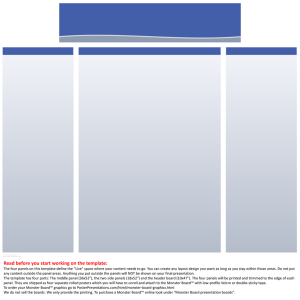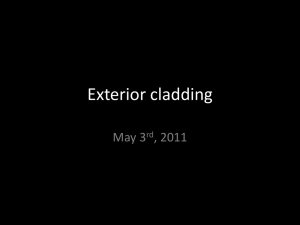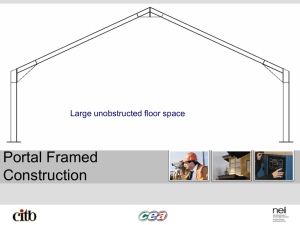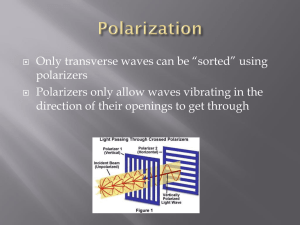Nichiha_FiberCementPanelsasRainScreens_Final
advertisement
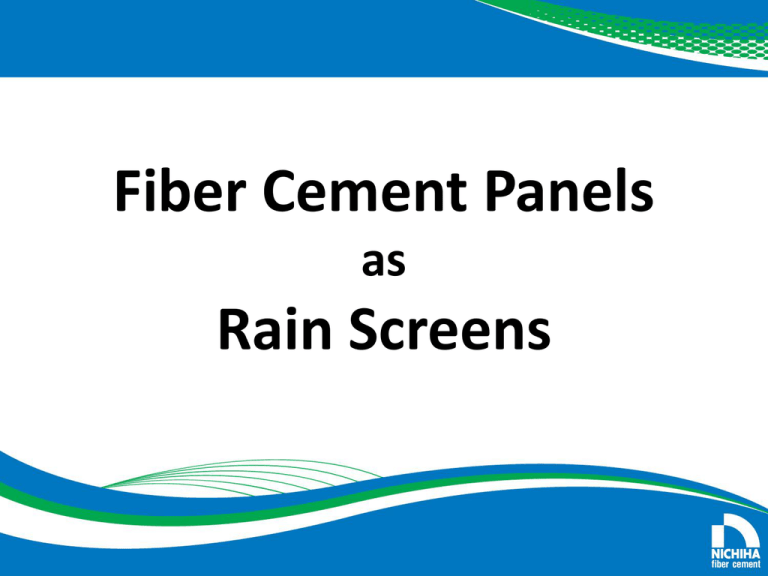
Fiber Cement Panels as Rain Screens AIA Best Practices Nichiha sponsors this learning unit provided by Hanley Wood, a registered provider with the American Institute of Architects (AIA) Continuing Education Systems (CES). Credits earned on completion of this program will be reported to CES Records for AIA members. Certificates of Completion are available for recordkeeping and selfreporting purposes. This program is registered with the AIA/CES for continuing professional education. As such, it does not include content that may be deemed or construed to be an approval or endorsement by the AIA of any material of construction or any method or manner of handling, using, distributing, or dealing in any material or product. Questions related to specific materials, and services should be directed to Nichiha after you complete this learning unit. Copyright Materials This presentation is protected by US and international copyright laws. Reproduction, distribution, display and use of the presentation without written permission of the speaker is strictly prohibited. © Nichiha, 2012 Course Description Moisture intrusion in a wall system can be the cause of building defects, as well as health ailments for the building's occupants, making rainscreens a very important tool in water mitigation. This course will review the cause and effects of moisture intrusion, and more specifically the forces that drive rainwater into a building. We will identify different rainscreen technologies and ASTM testing standards that measure their performance. We will discuss fiber cement panels and how they can be used as a rainscreen to reduce moisture build-up, rotting interior walls and mold growth. By the end of the course you will understand basic design approaches and guidelines for installing fiber cement panels as a rainscreen. Learning Objectives • Describe the cause and effect of moisture intrusion in a wall system. • Examine the importance of rainscreens and weather barriers in water mitigation. • Identify examples of rainscreen technology and testing standards that measure their performance. • Discuss how some fiber cement panels act as a rainscreen and review guidelines for their installation as a rainscreen. Learning Objective One Describe the cause and effect of moisture intrusion in a wall system. Causes of Moisture Intrusion • Construction moisture • Elevated relative humidity • Precipitation • Ground water sources Causes of Moisture Intrusion Bulk moisture intrusion from: • Faulty or non-existent flashing • Poor site grading • Improper or non-existent rain screens • Poorly maintained or non-existent gutters and downspouts Water concentrates around: • • • • Window and door openings Roofline Construction joints Base of exterior walls Effects of Moisture Intrusion Moisture related problems • Structural wood decay • High indoor humidity • Condensation Structural Wood Decay • Expanding soil • Metal corrosion • Ice dams Ice Dam • Insect infestation • Mold growth Insect Infestation Effects of Moisture Intrusion Building materials are common fungi food source • Wood • Paper • Carpet • Insulation Learning Objective Two Examine the importance of rainscreens and weather barriers in water mitigation. Causes of Rainwater Penetration Rainscreens prevent rainwater penetration through walls caused by: • Water on substrate • Openings in substrate • Pressure differences that force water through substrate Pressure Differences and Water Ingress Raindrop Kinetic Energy Surface Tension Gravity Pressure Differences and Water Ingress Wind-Driven Rain Capillary Action Rainscreen Overview Rather than attacking the symptoms of moisture intrusion, rainscreens tackle the source – the forces that drive water into the building shell. Historic Norwegian Building Demonstrating Early Rainscreen with Lap Siding Rain Fly – Simple Rainscreen Rainscreen Overview Rainscreen The exterior surface of a building (cladding), which has direct contact with the weather and elements, but is not directly attached to the building substructure. Rainscreen Wall Assembly Three required components of a rainscreen wall assembly • Outer leaf – vented or porous cladding • Air chamber – separates cladding from support wall • Inner leaf – drainage layer protecting against moisture that bypasses both the cladding and air cavity Weather Barrier • Housewrap, building paper or rigid foam board installed over sheathing and behind exterior siding. • Water shedding and high moisture vapor transmission rate • Integrate with other building envelope elements: • • • • • Structure Insulation Vapor retarder Air retarder Flashing system 4 Components of Building Envelope Design • • • • Deflection Drainage Drying Durability Learning Objective Three Identify examples of rainscreen technology and testing standards that measure their performance. Types of Rainscreens Common rainscreen claddings: • • • • • Brick veneer Stud back-up Stucco Clapboard Panelized wall systems: Metal Alpolic Fiber cement Brick Veneer Panelized Wall System Types of Rainscreens D/BV Rainscreen: PER Rainscreen: Prevents most rainwater prevention at outer surface but provides drainage and evaporation for what does get through Prevention of all rainwater penetration while air is forced to penetrate wall cavity in order to equalize pressure on exterior and interior of outer wall D/BV Rainscreen • Water allowed to enter cavity • Weather resistive barrier prevents water from entering building • Cavity is vented so water can evaporate • Not pressure-equalized because flow of air in cavity is constant but not uniform PER Rainscreen Pressure measured on exterior of rainscreen is equal to pressure in air cavity between rainscreen and substrate PER Rainscreen • Cavity is broken into horizontal and vertical compartments. • These breaks provide air flow into and out of the cavity. • Air space responds to wind gusts, reducing rain-driving force • Size and locations of breaks vary within same structure PER Rainscreen • PER technology demands additional detailing • Short-lived sealants and foam gaskets will decrease effectiveness • Mechanical seals such as metal flashing or gasketed furring strips are more permanent Modified Rainscreen • Wide variety of building envelope materials used in new ways as a successful rainscreen approach. • For example: Drainscreens Cladding panels installed with clip systems Drainable tracks Modified Rainscreen If care is taken in the design stage with use of proper materials, a number of combinations are available to create a rainscreen that will offer a lasting line of defense against water penetration into structures. Measuring Performance Test methods to determine performance of rainscreen products: AAMA 508-7 Voluntary Test Method and Specification for Pressure Equalized Rain Screen Wall Cladding Systems AAMA 509-9 Voluntary Test and Classification Method of Drained and Back Ventilated Rain Screen Wall Cladding Systems AAMA 508-7 (PER System) Four design requirements for Test AAMA 508-7: • Water penetration must be prevented throughout. • Should water vapor diffuse through the interior wall (from inside structure into the cavity), then it must vent to the exterior (outside the rainscreen). • The weather barrier must resist the full positive (internal to external) and negative (external to internal) wind load. • System must not trap or conceal water and it must be able to control rainwater penetration. AAMA 509-9 (D/BV Systems) Four design requirements for Test AAMA 509-9: • Water entry through the weather barrier must be prevented. • Weather barrier must be the primary weather protection. • The system must be able to manage and drain any water entering the cavity behind the cladding and must be sufficiently vented to allow the cavity to dry. • If water vapor enters from the interior of the building through the weather barrier into the cavity, it must be allowed to vent and or drain to the exterior. Learning Objective Four Discuss how some fiber cement panels act as a rainscreen and review guidelines for their installation as a rainscreen. Introduction to Fiber Cement Panels Introduction to Fiber Cement Panels • Available in a variety of finishes • Quick and easy to install • Interior and exterior applications • Pre-finished • Used in variety of construction projects • Specified for green projects Benefits of Fiber Cement Panels • Flexibility • Ease of Installation • Low Maintenance • Reduced Moisture • Durability Fiber Cement Panels as Rainscreen The system is a form of double-wall construction that uses an outer layer to keep out the rain and an inner layer to provide thermal insulation, prevent excessive air leakage and carry wind loading. Fiber Cement Panels as Modified Rainscreen Clip Panel • Paneled wall system installed to framing using clips that hold panels away from structure • Clips provide different depths of air space depending on designer’s preference • Installed over a starter track with weep holes Fiber Cement Panels as Rainscreen • Rot-resistant • Termite-resistant • Low-maintenance • No sealant or caulk necessary • No special tools or subs needed for installation • Can be installed over various substrates • Little to no exposed fasteners Managing Water Penetration by Gravity • Provide drainage holes for all horizontal surfaces that can act as troughs. • Provide a minimum slope of 2% on horizontal surfaces to prevent flow to the interior. • Provide gaskets or sealants for closed vertical joints within a two-stage joint. • Provide shielding for open joints. Managing Water Penetration by Capillary Action • Drainage and vent holes should be minimum 7/16” wide to avoid bridging by water. • Choose thicker materials that will delay or minimize water absorption. Air Pressure Difference, Surface Tension & Kinetic Energy Air Pressure Difference • Achieve some degree of pressure equalization across the cladding, its joints and junctions. • Air pressure across the cladding is a function of the effectiveness of the weather barrier system, the size of the venting in the cladding, the volume of air chamber between the weather barrier, and the stiffness of the chamber. Surface Tension • Add drip caps under any projecting horizontal surface such as windowsills, balcony floors or soffits. • Put a drip edge on flashing. Kinetic Energy • Protect openings from direct rain entry by overlapping materials, sealant, or gaskets. Panel Installation • Clip system creates up to ½” air space behind the panels • Apply moisture barrier over sheathing material • Mark location of studs • Panels can be installed over: Wood or steel framing Structural insulated panels Pre-engineered metal Concrete masonry units • Panels installed left to right and bottom to top Panel Installation • Starter track installed using nails or screws that penetrate studs or sill plate by 1” min. • Install and level starter track 2-6” min. • To apply brick or stone fiber cement panels to CMUs, wall must be furred out using pressure-treated lumber or min. 18 gauge metal hat channel. 2” -6" Panel Installation • Place first fiber cement panel in starter track and attach using attachment clips at each stud. • Screws must penetrate wood framing members a minimum of 1", ½” for metal. For 1/2" sheathing, use longer fasteners as specified by the manufacturer. • Before proceeding to next panel, verify that first panel is level. Panel Installation • The next panel installs tightly on both the horizontal and vertical joints. • Make sure that the panel edges are properly seated in the clips. The vertical and horizontal joints of each panel are ship-lapped and do not require caulking unless cut. • Install joint clip at the top of each vertical joint. • Additional short clips must be inserted at the bottom of vertical joints. Summary At the end of the day, the industry has come a long way in developing performance criteria for rainscreen systems that should be used when designing a rainscreen. A rainscreen must be viewed as a system and not as its individual parts. Guessing must be taken out of the design stage and all parts have to be tested to make sure they will work well together in every possible design combination. Thank You Thank you for your time and participation in this course. Please contact Nichiha if you have questions related to the information presented within this program. You will now take a 10-question quiz. PROPERTIES On passing, 'Finish' button: On failing, 'Finish' button: Allow user to leave quiz: User may view slides after quiz: User may attempt quiz: Close Window Goes to Slide After user has completed quiz After passing quiz Unlimited times
